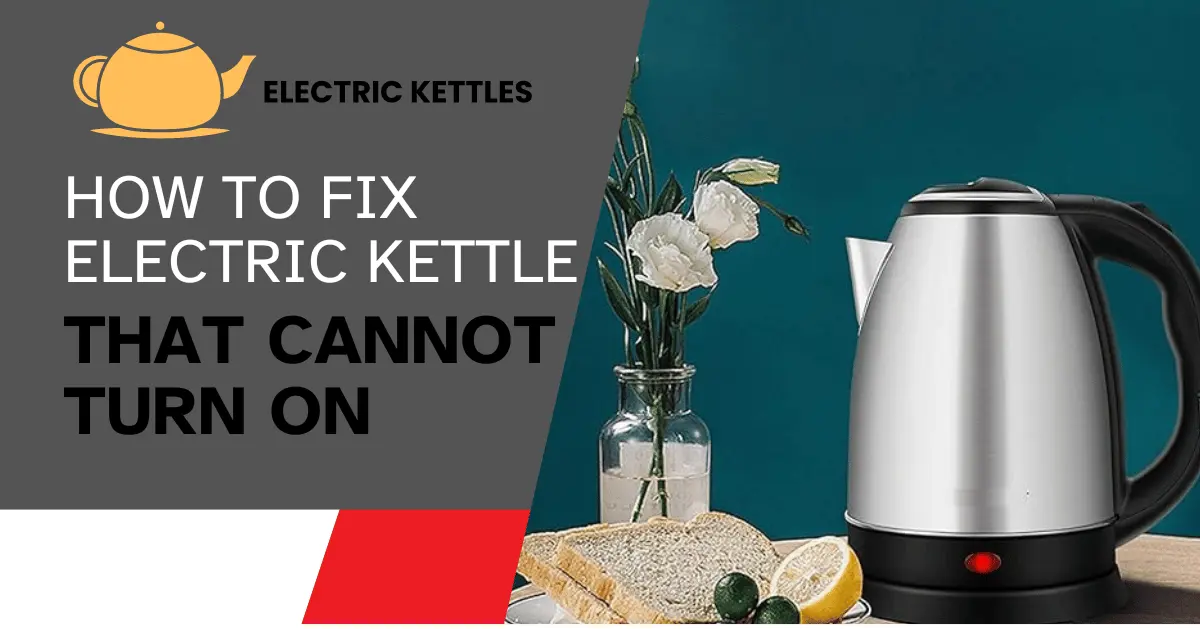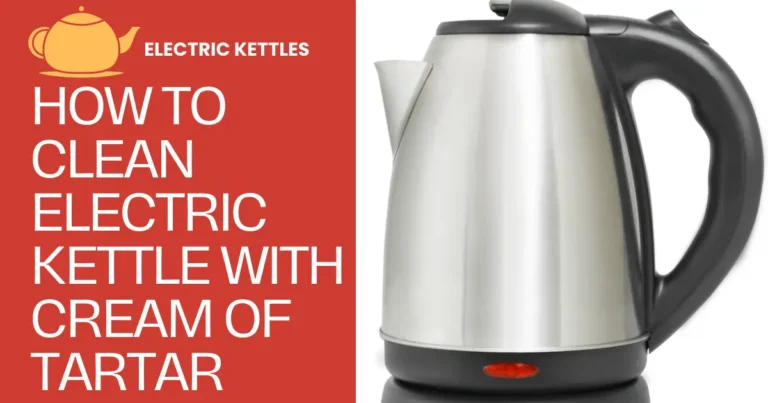How to Fix Electric Kettle That Cannot Turn On
Electric kettles can have several problems over time. Some kettles may not turn on, while others might stop heating the water properly. Common issues include a faulty power cord, a broken switch, or a damaged heating element. In some cases, the kettle might need a simple reset to work again.
By checking the power source, cord, and other parts, you can often fix the problem yourself. This saves time and money. Regular maintenance and quick fixes can extend the life of your kettle.
Table of Contents
Step#1 Check the Power Source
The first thing to do when your electric kettle won’t turn on is to check the power source. Make sure the kettle is plugged into a working power outlet. Sometimes, the plug may not be fully inserted into the socket, causing it not to connect properly. Ensure it’s securely plugged in before moving to other checks.
Next, test the outlet by plugging in another small appliance, such as a phone charger or toaster. If the other device doesn’t work, the issue might be with the outlet itself. You should check your home’s fuse box or circuit breaker to see if a fuse has blown or if the circuit has tripped.
If the outlet is functioning well, unplug the kettle and examine the plug and cord. Look for any signs of wear or damage, such as frayed wires. A damaged cord could prevent the kettle from receiving power, and if this is the case, it will need to be replaced before the kettle can work properly.
Step#2 Examine the Power Cord
After checking the power source, the next step is to examine the power cord. Over time, cords can wear out or get damaged. Carefully inspect the entire length of the cord for any visible signs of wear, such as fraying, cuts, or exposed wires. A damaged cord can prevent the kettle from receiving power and may even be a safety hazard.
If you notice any damage, it’s important to stop using the kettle immediately. A frayed or broken cord can cause electric shocks or fires. In this case, replacing the cord is necessary. Some kettles have detachable cords, making them easier to replace. For others, you may need to consult the manufacturer or a professional repair service.
In cases where the cord appears to be in good condition, check the connection between the cord and the kettle. Sometimes the cord might not be properly attached, especially if it’s detachable. Reattach it securely, then test the kettle again to see if this solves the issue.
If the cord is undamaged and securely connected but the kettle still won’t turn on, the problem may lie elsewhere, such as with the switch or heating element, which you can address in the next steps.
Step#3 Inspect the Kettle’s Switch
If your kettle still won’t turn on after checking the power source and cord, the next step is to inspect the switch. The switch is responsible for turning the kettle on and off, and if it’s faulty, the kettle won’t start. Begin by making sure the switch is not stuck or blocked. Dirt or residue from frequent use can accumulate and prevent the switch from functioning properly.
Try pressing the switch a few times to see if it clicks into place as it should. If it feels loose, doesn’t click, or gets stuck, this might be the cause of the problem. You can clean the area around the switch using a dry cloth or a small brush to remove any debris. Avoid using water to clean the switch, as moisture can damage the internal components.
If cleaning doesn’t help, the switch itself could be broken internally. In this case, you might need to replace it. Some kettles allow for easy switch replacement, while others may require professional repair. If the switch continues to malfunction, consider contacting the manufacturer or a technician for further assistance.
Step#4 Test the Heating Element
If your kettle still isn’t working, it’s time to test the heating element. The heating element is the part that heats the water, and if it’s faulty, the kettle won’t function. To begin, unplug the kettle and ensure it’s completely cool. Turn the kettle over and inspect the base where the heating element is located. Look for any visible signs of damage, such as burn marks or corrosion, which can indicate a problem.
If the heating element appears undamaged but the kettle won’t turn on, it might have burned out internally. You can test the heating element using a multimeter if you’re comfortable with electrical checks. Set the multimeter to the resistance (ohms) setting and touch the probes to the element’s terminals. A functioning heating element will show some resistance. If the reading is zero or infinite, the element is faulty and needs to be replaced.
For kettles with a detachable heating element, you may be able to replace it yourself following the manufacturer’s instructions. If not, you might need to contact a professional for repair. Replacing a faulty heating element can restore your kettle’s functionality, but attempting repairs without the proper knowledge can be dangerous.
Step#5 Check the Thermal Fuse
The thermal fuse is a safety feature that prevents the kettle from overheating. If your kettle still won’t turn on after inspecting other parts, it’s time to check the thermal fuse. A blown thermal fuse will cut off the power to the kettle, and the appliance won’t heat up or function at all.
To begin, unplug the kettle and ensure it’s cool. The thermal fuse is usually located near the heating element at the base of the kettle. Unfortunately, most thermal fuses are not visible from the outside, so you may need to disassemble the kettle to access it. If you’re not comfortable taking apart the kettle, consider seeking professional help.
Once you’ve accessed the fuse, you can test it using a multimeter. Set the multimeter to continuity mode and touch the probes to both ends of the fuse. If the multimeter doesn’t beep or show continuity, the fuse is blown and needs to be replaced. Make sure to use a fuse with the same rating to avoid further issues.
Step#6 Resetting the Kettle
If your kettle isn’t turning on after checking the power, cord, switch, heating element, and thermal fuse, try resetting it. Some kettles come with a built-in reset feature, which can help resolve minor internal issues. This feature resets the kettle’s internal system, allowing it to start working again if it had tripped or malfunctioned due to overuse or overheating.
To reset the kettle, first unplug it and let it cool down completely. This is especially important if the kettle overheated during previous uses. Once it’s cool, locate the reset button, which is typically found at the bottom or near the base of the kettle. Press and hold the button for a few seconds, then release it. After doing this, plug the kettle back in and try turning it on again.
If your kettle doesn’t have a reset button, simply unplugging it and leaving it to cool for a few minutes may reset it. This method helps the kettle’s internal thermostat recalibrate itself. If the kettle still doesn’t turn on after resetting, there may be a more serious internal problem that requires professional assistance.
When to Contact a Professional
If you’ve tried all the basic troubleshooting steps checking the power source, cord, switch, heating element, thermal fuse, and resetting the kettle and it still won’t turn on, it may be time to contact a professional. Some problems, like complex electrical faults or issues with internal components, are difficult and unsafe to fix without the right tools and expertise.
You should also seek professional help if you notice any dangerous signs, such as burning smells, smoke, or sparks, as these indicate a serious internal issue. Attempting to repair these on your own can pose safety risks, including electric shocks or fire hazards. A professional technician can properly diagnose the issue and make safe, long-lasting repairs.
Conclusion
If your electric kettle won’t turn on, start by checking the power source and making sure the kettle is plugged in properly. Test the outlet with another device to ensure it’s working. Next, examine the power cord for any visible damage and check the switch to see if it’s stuck or broken. If these steps don’t solve the problem, inspect the heating element and thermal fuse, as these parts can also cause issues.
If your kettle still doesn’t work after trying all these troubleshooting steps, it’s time to contact a professional. Serious internal problems or safety concerns should be handled by someone with the right expertise. Regular maintenance and timely repairs can help keep your kettle in good working condition, ensuring it serves you well for a long time.







